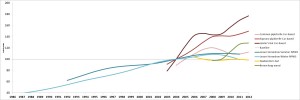With funding from the NPWS and NIEA and enormous help from volunteers, Bat Conservation Ireland has been tracking the yearly trends in three Irish bat species since 2003. The Car-based Bat Monitoring Scheme provides us with trends in the common pipistrelle, soprano pipistrelle and Leisler’s bat. Another scheme to monitor Daubenton’s bat has been running since 2006, and a scheme to count brown long-eared bats exiting from roosts began in 2007. The NPWS and Vincent Wildlife Trust have also been counting lesser horseshoe bats in the west of Ireland since the 1980s. Bat Conservation Ireland has recently begun to manage this scheme.
While we only have a limited timespan of trend data, thus far, all of the monitored species appear to be stable or increasing.
It is important to note, however, that increasing trends follow from considerable declines that are likely to have taken place in Ireland in the previous three centuries. At a local roost and habitat level bats remain vulnerable to threats such as water pollution, increased artificial night lighting, habitat and hedgerow loss, pesticides etc.
We are not currently tracking two of our rarest species – the whiskered and Natterer’s bats, simply because we do not have a reliable and cost-effective method for doing so. We hope to improve our knowledge of their island-wide distributions in the next BATLAS.
